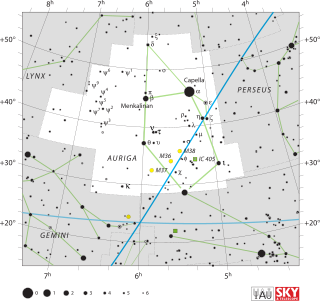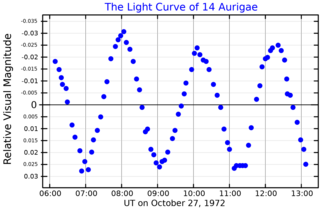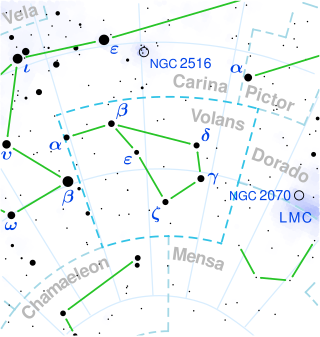Related Research Articles
Chi Scorpii, Latinized from χ Scorpii, is a single star in the zodiac constellation of Scorpius. It has an orange hue and can be faintly seen with the naked eye with an apparent visual magnitude of 5.24. Based upon parallax measurements, this star is around 448 light years from the Sun. The star is drifting closer with a radial velocity of −23.6 km/s.

Eta Volantis, Latinized from η Volantis, is a single star in the southern constellation of Volans. It has an apparent visual magnitude of 5.28, which is bright enough to be seen with the naked eye as a dim, white-hued star. Based upon parallax measurements, it is approximately 387 light years from the Sun. The star is moving further away from the Sun with a radial velocity of 20 km/s.

Delta Aurigae, Latinized from δ Aurigae, is the Bayer designation for an astrometric binary star in the northern constellation of Auriga. It is visible to the naked eye with an apparent visual magnitude of 3.715. Based upon its annual parallax shift of 23.06 mas, it is some 141 light-years distant from the Earth, give or take a three light-year margin of error. It is drifting further away with a radial velocity of +10 km/s. This star is the namesake for the Delta Aurigids, a meteor shower that occurs between October 6–15. The radiant point for this shower passes several degrees to the south of the star.

Nu Aurigae, Latinised from ν Aurigae, is the Bayer designation for a star in the northern constellation of Auriga. It is visible to the naked eye with an apparent visual magnitude of 3.96 and is approximately 200 light-years distant from the Earth. This is an evolved giant star with a stellar classification of G9.5 III. It is a red clump star, which indicates that it is generating energy through the fusion of helium at its core. The outer envelope has expanded to 18 times the radius of the Sun and cooled to 4,576 K, giving it the characteristic yellow-hued glow of a G-type star. It shines with 126 times the luminosity of the Sun.

Tau Aurigae, Latinized from τ Aurigae, is a star in the northern constellation Auriga. It is visible to the naked eye with an apparent visual magnitude of 4.505, and is approximately 207 light-years distant from Earth.
4 Andromedae, abbreviated 4 And, is a single star in the northern constellation of Andromeda. 4 Andromedae is the Flamsteed designation. It is dimly visible to the naked eye with an apparent visual magnitude of 5.308. Based upon an annual parallax shift of 9.16 mas as seen from Earth's orbit, it is located 356 light years away. At this distance, interstellar extinction diminishes the apparent magnitude of 4 And by 0.5326 magnitudes. The star is moving closer with a heliocentric radial velocity of −11 km/s. It has a magnitude 11.7 visual companion at an angular separation of 51.10″ along a position angle of 348°, as of 2002.
56 Andromedae, abbreviated 56 And, is a probable binary star system in the northern constellation of Andromeda. 56 Andromedae is the Flamsteed designation. It has a combined apparent visual magnitude of 5.69, which is just bright enough to be dimly visible to the naked eye under good seeing conditions. The distance to this system can be ascertained from its annual parallax shift, measured at 9.9 mas with the Gaia space observatory, which yields a separation of 330 light years. It is moving further from the Earth with a heliocentric radial velocity of +62 km/s and is traversing the celestial sphere at a relatively high rate of 0.183″ per year. This pair is positioned near the line of sight to the open cluster NGC 752, located 1,490 light-years away.
16 Aurigae is a triple star system located 232 light years away from the Sun in the northern constellation of Auriga. It is visible to the naked eye as a faint, orange-hued star with an apparent visual magnitude of 4.547, and is located about 2/3 of the way from Capella toward Beta Tauri. It also lies in the midst of the Melotte 31 cluster, but is merely a line-of-sight interloper. The system has a relatively high proper motion, advancing across the celestial sphere at the rate of 0.166 arc seconds per annum, and is moving closer to the Earth with a heliocentric radial velocity of −28 km/s.

14 Aurigae is a quadruple star system located 269 light years away from the Sun in the zodiac constellation of Auriga. It has the variable star designation KW Aurigae, whereas 14 Aurigae is the Flamsteed designation. It is visible to the naked eye as a faint, white-hued star with a combined apparent visual magnitude of 5.01. The system is moving closer to the Sun with a heliocentric radial velocity of −9 km/s.
HD 222093 is a double star in the equatorial constellation of Aquarius. It has an orange hue and is visible to the naked eye with an apparent visual magnitude of 5.68. The system is located at a distance of approximately 293 light years from the Sun based on parallax, but is drifting closer with a radial velocity of −13 km/s.

V538 Aurigae is a single star in the northern constellation of Auriga. With an apparent visual magnitude of 6.23, this star requires good dark sky conditions to view with the naked eye. It is located at a distance of 40.0 light-years (12.3 pc) from Sun based on parallax. The star is drifting further away with a radial velocity of 0.9 km/s. It is a member of the Local Association, and is most likely a thin disk star.
HD 112028 is an evolved star in the northern constellation of Camelopardalis. It has spectral peculiarities that have been interpreted as a shell, and also relatively weak magnesium and silicon lines. Its spectral class has been variously assigned between B9 and A2, and its luminosity class between a subgiant and bright giant.
46 Ceti is a single star in the equatorial constellation of Cetus. It is visible to the naked eye with an apparent visual magnitude of 4.9. The distance to this star, as determined from an annual parallax shift of 11.9 mas, is about 273 light years. It is moving closer to the Earth with a heliocentric radial velocity of −23 km/s, and is expected to come as close as 184 light-years in 2.2 million years.

1 Geminorum is a star in the constellation Gemini. Its apparent magnitude is 4.15.
60 Herculis is a single star located 134 light years away from the Sun in the northern constellation of Hercules, and is positioned just seven degrees away from Rasalgethi. It is visible to the naked eye as a faint, white-hued star with an apparent visual magnitude of 4.871. This star is moving closer to the Earth with a heliocentric radial velocity of −4 km/s.
26 Hydrae is a binary star system located 334 light years away from the Sun in the equatorial constellation of Hydra. It is visible to the naked eye as a faint, yellow-hued point of light with a combined apparent visual magnitude of 4.77, just a few degrees away from Alphard. The system is moving closer to the Earth with a leisurely radial velocity of -1 km/s.
69 Virginis is a single star in the zodiac constellation of Virgo, located about 259 light years away. It is visible to the naked eye as a faint orange-hued star with an apparent visual magnitude of 4.76, although it is a suspected variable that may range in magnitude from 4.75 down to 4.79. This object is moving closer to the Earth with a heliocentric radial velocity of −13 km/s. The light from this star is polarized due to intervening interstellar dust.
HR 4699 is a single star in the southern constellation of Corvus. It is orange in hue and is dimly visible to the naked eye with an apparent visual magnitude of +5.14. This star is located at a distance of approximately 201 light years from the Sun based on parallax. It is drifting further away with a radial velocity of +14 km/s, after come to within 45.1 light-years some four million years ago.

HD 70514, also known as HR 3280, is a solitary, orange hued star located in the southern circumpolar constellation Volans, the flying fish. It has an apparent magnitude of 5.06, making it one of the brighter members of this generally faint constellation. Based on parallax measurements from the Gaia spacecraft, the star is estimated to be 298 light years distant. It appears that its distance to the Solar System isn't changing, having a heliocentric radial velocity of 0 km/s. Eggen (1994) lists it as a member of the thin disk population.
HR 2131 is a solitary star in the southern constellation Columba. It has an apparent magnitude of 5.52, allowing it to be faintly seen with the naked eye. The object is located at a distance of 670 light years but is receding with a heliocentric radial velocity of 19 km/s.
References
- 1 2 3 4 5 6 7 8 9 Brown, A. G. A.; et al. (Gaia collaboration) (August 2018). "Gaia Data Release 2: Summary of the contents and survey properties". Astronomy & Astrophysics . 616. A1. arXiv: 1804.09365 . Bibcode: 2018A&A...616A...1G . doi: 10.1051/0004-6361/201833051 . Gaia DR2 record for this source at VizieR.
- 1 2 3 4 Kharchenko, N. V.; et al. (2007). "Astrophysical supplements to the ASCC-2.5: Ia. Radial velocities of ~55000 stars and mean radial velocities of 516 Galactic open clusters and associations". Astronomische Nachrichten. 328 (9): 889. arXiv: 0705.0878 . Bibcode:2007AN....328..889K. doi:10.1002/asna.200710776. S2CID 119323941.
- 1 2 Mermilliod, J.-C. (1986). "Compilation of Eggen's UBV data, transformed to UBV (unpublished)". Catalogue of Eggen's UBV Data. Bibcode:1986EgUBV........0M.
- 1 2 Massarotti, Alessandro; Latham, David W.; Stefanik, Robert P.; Fogel, Jeffrey (2008). "Rotational and Radial Velocities for a Sample of 761 Hipparcos Giants and the Role of Binarity". The Astronomical Journal. 135 (1): 209–231. Bibcode:2008AJ....135..209M. doi: 10.1088/0004-6256/135/1/209 . S2CID 121883397.
- ↑ Allende Prieto, C.; Lambert, D. L. (1999). "Fundamental parameters of nearby stars from the comparison with evolutionary calculations: masses, radii and effective temperatures". Astronomy and Astrophysics. 352: 555–562. arXiv: astro-ph/9911002 . Bibcode:1999A&A...352..555A.
- 1 2 3 4 5 6 Feuillet, Diane K.; Bovy, Jo; Holtzman, Jon; Girardi, Léo; MacDonald, Nick; Majewski, Steven R.; Nidever, David L. (2016). "Determining Ages of APOGEE Giants with Known Distances". The Astrophysical Journal. 817 (1): 40. arXiv: 1511.04088 . Bibcode:2016ApJ...817...40F. doi: 10.3847/0004-637X/817/1/40 . S2CID 118675933.
- 1 2 Martig, Marie; Fouesneau, Morgan; Rix, Hans-Walter; Ness, Melissa; Mészáros, Szabolcs; García-Hernández, D. A.; Pinsonneault, Marc; Serenelli, Aldo; Aguirre, Victor Silva; Zamora, Olga (2016). "Red giant masses and ages derived from carbon and nitrogen abundances". Monthly Notices of the Royal Astronomical Society. 456 (4): 3655. arXiv: 1511.08203 . Bibcode:2016MNRAS.456.3655M. doi: 10.1093/mnras/stv2830 .
- ↑ Eggleton, P. P.; Tokovinin, A. A. (September 2008), "A catalogue of multiplicity among bright stellar systems", Monthly Notices of the Royal Astronomical Society , 389 (2): 869–879, arXiv: 0806.2878 , Bibcode:2008MNRAS.389..869E, doi: 10.1111/j.1365-2966.2008.13596.x , S2CID 14878976.